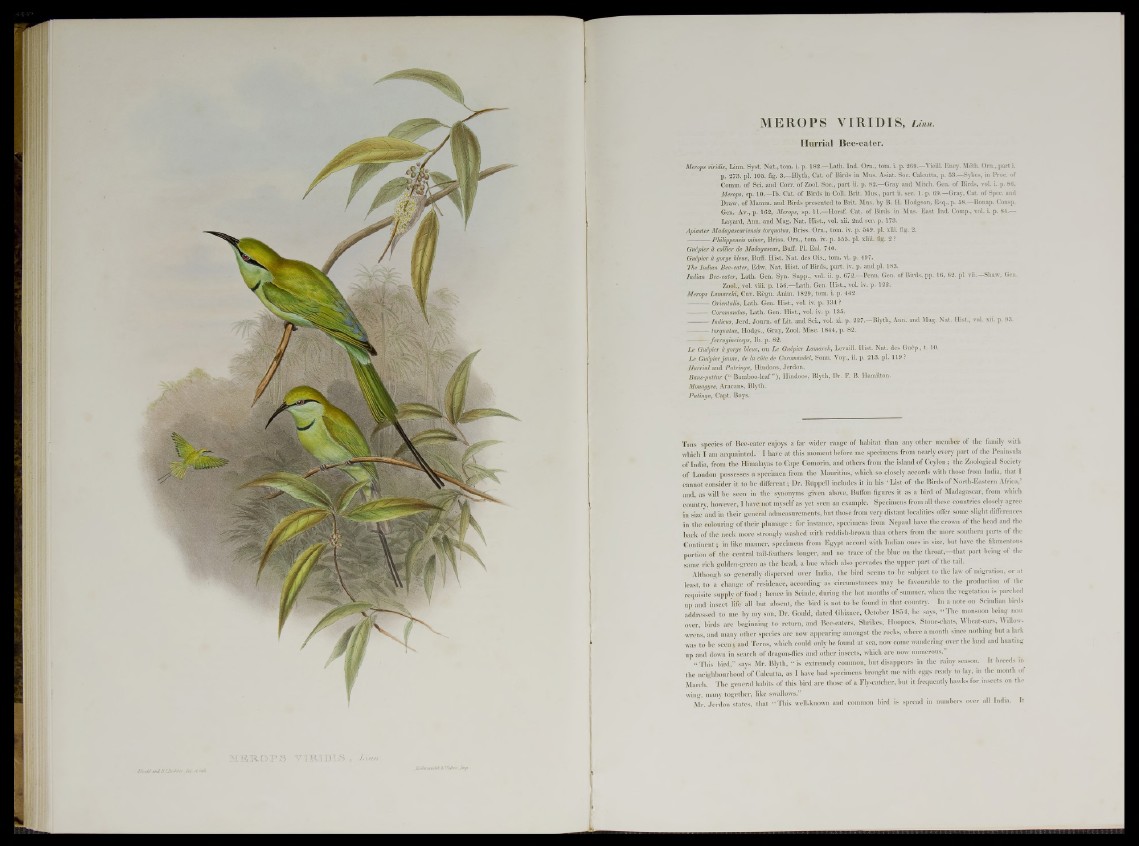
JGould u n i U.C-RMiler, M . e l (d/t/
MEROPS VIRIDIS, Linn.
H u rria l Bee-eater.
Merops viridis, Linn. Syst. N a t, tom. i. p. 182.—Lath. Ind. Orn., tom. i. p. 269.—Vieill. Ency. Méth. Orn., p art i.
p. 273. pl. 105. fig. 3.—Blyth, Cat. of Birds in Mus. Asiat. Soc. Calcutta, p. 53.—Sykes, in Proc. of
Comm, of Sci. and Corr. of Zool. Soc., p a rt ii. p. 82.—Gray and Mitch. Gen. of Birds, vol. i. p. 86,
Merops, sp. 10.—lb. Cat. of Birds in Coll. Brit. Mus., p art ii. sec. 1. p. 69.—Gray, Cat. of Spec, and
Draw, of Mamm. and Birds presented to Brit. Mus. by B. H. Hodgson, Esq., p. 58.—Bonap. Consp.
Gen. Av., p. 162, Merops, sp. 11.—Horsf. Cat. of Birds in Mus. East Ind. Comp., vol. i. p. 84.—
Layard, Ann. and Mag. Nat. Hist., vol. xii. 2nd ser. p. 173.
Apiaster Madagascariensis torquatus, Briss. Orn., tom. iv. p. 549. pi. xlii. fig. 2.
---------- Philippensis minor, Briss. Orn., tom. iv. p. 555. pi. xliii. fig; 2 ?
Guêpier à collier de Madagascar, Buff. PI. Enl. 740.
Guêpier à gorge bleue, Buff. Hist. Nat. des Ois., tom. vi. p. 497.
The Indian Bee-eater, Edw. Nat, Hist, of Birds, part. iv. p. and pi. 183.
Indian Bee-eater, Lath. Gen. Syn. Supp., vol. ii. p. 672 —Penn. Gen. of Birds, pp. 16, 62. pi. vii.—Shaw, Gen.
Z00I4 vol. viii. p. 156.—Lath. Gen. Hist., vol. iv. p. 122.
Merops Lamarcki, Cuv. Règn. Anim. 1829, tom. i. p. 442
Orientalis, Lath. Gen. Hist., voL iv. p. 134 ?
----------Coromandus, Lath. Gen. Hist., vol. iv. p. 135.
Indicus, Jerd. Joum. of Lit. and Sci.-, vol. xi. p. 227.—Blyth, Ann. and Mag. Nat. Hist., vol. xii. p. 93.
----------torquatus, Hodgs., Gray, Zool. Misc. 1844, p. 82.
^— ferrugineiceps, lb. p. 82.
Le Guêpier à gorge bleue, ou Le Guêpier Lamarck, Levaill. Hist. Nat. des Guêp., t. 10.
Le Guêpier jaune, delà côte de Coromandel, Sonn, Voy., ii. p. 213. pl. 119 ?
Hurrial and Putringa, Hindoos, Jerdon.
Bans-puttur ( “ Bamboo-leaf Hindoos, Blyth, Dr. F. B. Hamilton.
Monagyee, Aracans, Blyth.
Putinga, Capt. Boys.
T h is species o f Bee-eater enjoys a for wider range of habitat than any other member of the family with
which I am acquainted. I have at this moment before me specimens from nearly every part of the Peninsula
of India, from the Himalayas to Cape Comorin, and others from the island of Ceylon; the Zoological Society
of London possesses a specimen from the Mauritius, which so closely accords with those from India, that I
cannot consider it to be different; Dr. Riippell includes it in his ‘ List of the Birds of North-Eastern Africa,’
and, as will be seen in the synonyms given above, Buffon figures it as a bird of Madagascar, from which
country, however, I have not myself as yet seen an example. Specimens from all these countries closely agree
in size and in their general admeasurements, but those from very distant localities offer some slight differences
in the colouring of their plumage : for instance, specimens from Nepaul have the crown of the head and the
back of the neck more strongly washed with reddish-brown than others from the more southern parts of the
Continent 5 in like manner, specimens from Egypt accord with Indian ones in size, but have the filamentous
portion of the central tail-feathers longer, and no trace of the blue on the throat,—that part being of the
same rich golden-green as the head, a hue which also pervades the upper part of the tail.
Although so generally dispersed over India, the bird seems to Be subject to the law of migration, or at
least, to a change of residence, according as circumstances may be favourable to the production of the
requisite supply of food; hence in Scinde, during the hot months of summer, when the vegetation is parched
up and insect life all but absent, the bird is not to be found in that country. In a note on Scmdian birds
addressed to me by my son, Dr. Gould, dated Gliiznee, October 1854, he says, “ The monsoon being now
over, birds are beginning to return, and Bee-eaters, Shrikes, Hoopoes, Stone-chats, Wheat-ears, Willow-
wrens, and many other species are now appearing amongst the rocks, where a month since nothing but a lark
was to be seen j and Terns, which could only be found at sea, now come wandering over the land and hunting
up and down in search of dragon-flies and other insects, which are now numerous.”
" This bird,” says Mr. Blyth, “ is extremely common, but disappears in the rainy season. It breeds in
the neighbourhood of Calcutta, as I have had specimens brought me with eggs ready to lay, in the month of
March. The general habits of this bird are those of a Fly-catcher, but it frequently hawks for insects on the
wing, many together, like swallows.”
Mr. Jerdon states, that “This well-known and common bird is spread in numbers over all India. It